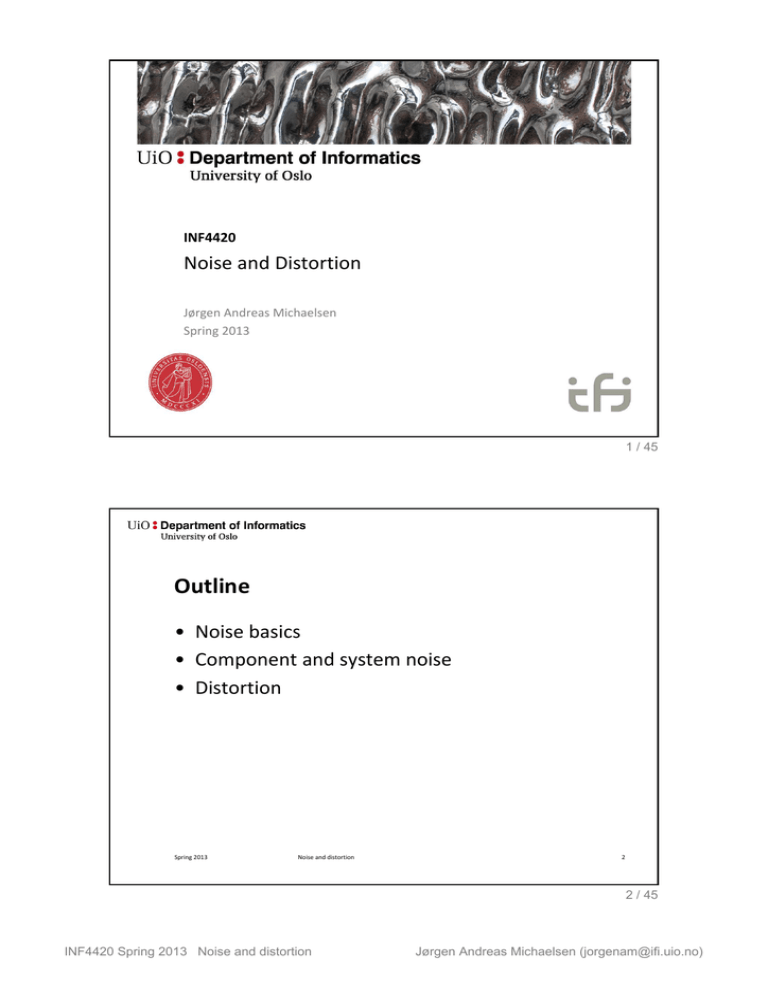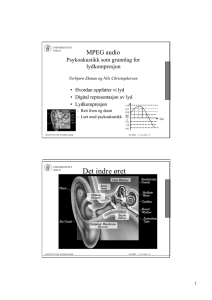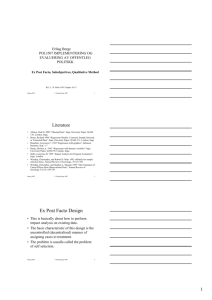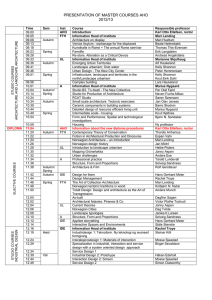Noise and distortion
advertisement

INF4420 Noise and Distortion Jørgen Andreas Michaelsen Spring 2013 1 / 45 Outline • Noise basics • Component and system noise • Distortion Spring 2013 Noise and distortion 2 2 / 45 INF4420 Spring 2013 Noise and distortion Jørgen Andreas Michaelsen (jorgenam@ifi.uio.no) Introduction We have already considered one type of noise in the layout lecture: Interference—Other circuits or other parts of the circuit interfering with the signal. E.g. digital switching coupling through to an analog signal through the substrate or capacitive coupling between metal lines. We mitigate this interference with layout techniques. True noise is random and zero mean! Spring 2013 Noise and distortion 3 3 / 45 Introduction TV Static Stock Video by REC Room Spring 2013 Noise and distortion 4 4 / 45 INF4420 Spring 2013 Noise and distortion Jørgen Andreas Michaelsen (jorgenam@ifi.uio.no) Introduction We do not know the absolute value, but … • We know the average value • We know the statistical and spectral properties of the noise Spring 2013 Noise and distortion 5 5 / 45 Introduction • Noise (power) is always compared to signal (power) • How clearly can we distinguish the signal from the noise (SNR) Spring 2013 Noise and distortion 6 6 / 45 INF4420 Spring 2013 Noise and distortion Jørgen Andreas Michaelsen (jorgenam@ifi.uio.no) Introduction • Why is noise important? • Signal headroom is reduced when the supply voltage is reduced. • Supply voltage is reduced because of scaling (beneficial for digital, less power consumption) • Noise is constant. • Noise limits performance of our circuits (along with mismatch, etc.) Spring 2013 Noise and distortion 7 7 / 45 Signal power • Sine wave driving a resistor dissipates power • The average voltage of the sine wave is zero • The average power dissipated is not zero 1 𝑃= 2𝜋 𝑣2 1 = 2𝜋 Spring 2013 2𝜋 0 𝑉𝐴2 sin2 𝑥 𝑑𝑥 𝑅 2𝜋 0 𝑉𝐴2 sin2 𝑥 𝑑𝑥 Noise and distortion Mean square 𝑉 value, RMS is 𝐴 2 𝑉𝐴2 = 2 8 8 / 45 INF4420 Spring 2013 Noise and distortion Jørgen Andreas Michaelsen (jorgenam@ifi.uio.no) White noise White refers to the spectrum, constant PSD 𝑉𝑛 𝑓 = constant Resistors exhibit white noise only (ideally). Random thermal motion of electrons (thermal noise) 𝑉𝑅2 𝑓 = 4𝑘𝑇𝑅 ⇔ 𝐼𝑅2 = 1 kΩ resistor ≈ 4 Spring 2013 4𝑘𝑇 𝑅 nV @ RT (useful to remember) Hz Noise and distortion 9 9 / 45 Filtering noise • In most circuits we have capacitors (noise free) • There is always some parasitic capacitance present. • White noise is filtered: the constant PSD is shaped. Spring 2013 Noise and distortion 10 10 / 45 INF4420 Spring 2013 Noise and distortion Jørgen Andreas Michaelsen (jorgenam@ifi.uio.no) Filtering noise Spring 2013 Noise and distortion 11 11 / 45 Total noise We find the total noise by integrating from 0 to ∞. This is a finite value because of the filtering. ∞ 0 1 1 + 𝑗2𝜋𝑓𝑅𝐶 1st order lowpass filter magnitude response 2 4𝑘𝑇𝑅 𝑑𝑓 = Resistor noise 𝑘𝑇 𝐶 Important! Total noise is independent of R and defined by C! Spring 2013 Noise and distortion 12 12 / 45 INF4420 Spring 2013 Noise and distortion Jørgen Andreas Michaelsen (jorgenam@ifi.uio.no) Noise bandwidth Find a frequency, such that when we integrate the ideal constant PSD up to this frequency, the total noise is identical. This is the equivalent noise BW. 𝜋 2 For 1st order filtered noise: 𝑓𝑐 = Spring 2013 Noise and distortion 𝜋 1 2 2𝜋𝑅𝐶 = 1 4𝑅𝐶 13 13 / 45 Adding noise sources If the noise sources are uncorrelated (common assumption): 2 = 𝑉2 + 𝑉2 𝑉𝑛𝑜 𝑛1 𝑛2 Generally: 2 = 𝑉 2 + 𝑉 2 + 2𝐶𝑉 𝑉 𝑉𝑛𝑜 𝑛1 𝑛2 𝑛1 𝑛2 𝐶 is the correlation coefficient. Spring 2013 Noise and distortion 14 14 / 45 INF4420 Spring 2013 Noise and distortion Jørgen Andreas Michaelsen (jorgenam@ifi.uio.no) Signal to noise ratio SNR ≡ 10 log10 signal power dB noise power Example: Best case signal swing, 𝑉𝐴 = 𝑉𝐷𝐷 , 2 noise is 𝑘𝑇 . 𝐶 2 𝐶𝑉𝐷𝐷 SNR = 8𝑘𝑇 If 𝑉𝐷𝐷 is reduced, 𝐶 must increase: More power (-) Spring 2013 Noise and distortion 15 15 / 45 Sampled noise When sampling signals, the sampled spectrum only represents frequencies up to the Nyquist frequency (half the sampling frequency). Frequencies beyond are aliased down to this range. (More on this in a later lecture). The total noise is 𝑘𝑇 still the same, . 𝐶 Spring 2013 Noise and distortion 16 16 / 45 INF4420 Spring 2013 Noise and distortion Jørgen Andreas Michaelsen (jorgenam@ifi.uio.no) 1/f noise So far, we have considered white noise (with filtering). Transistors exhibit significant flicker (1/f) noise. The PSD is proportional to the inverse of the frequency. 𝑉𝑛2 𝑓 = Spring 2013 constant 𝑓 Noise and distortion 17 17 / 45 Components • Resistors exhibit white noise where voltage noise is proportional to resistance. • Diodes exhibit white noise (shot noise) where noise current is proportional to diode current. Spring 2013 Noise and distortion 18 18 / 45 INF4420 Spring 2013 Noise and distortion Jørgen Andreas Michaelsen (jorgenam@ifi.uio.no) MOSFET noise White noise (channel resistance) Triode: 𝐼𝑑2 𝑓 = 4𝑘𝑇 𝑟𝑑𝑠 γ is process dependent, 2/3 for long-channel Active: 𝐼𝑑2 𝑓 = 4𝑘𝑇𝛾𝑔𝑚 or 𝑉𝑔2 𝑓 = 4𝑘𝑇𝛾 𝑔𝑚 Flicker noise (different models are used, we use the one from the textbook) 𝑉𝑔2 𝑓 = Spring 2013 𝐾 𝑊𝐿𝐶𝑜𝑥 𝑓 K is process dependent Noise and distortion 19 19 / 45 MOSFET noise • Total MOSFET noise is white noise + flicker noise • Higher 𝑔𝑚 attenuates the white noise contribution • Larger devices (gate area) reduces the flicker noise • We can reduce flicker noise using circuit techniques. E.g. in sampled analog systems we can sample the noise and subtract (correlated double sampling). Spring 2013 Noise and distortion 20 20 / 45 INF4420 Spring 2013 Noise and distortion Jørgen Andreas Michaelsen (jorgenam@ifi.uio.no) Input referred noise Amplifier not only amplifies the signal, but adds noise. Even though the amplifier noise is not physically present at the input, we can calculate an equivalent input noise, 𝑣𝑖𝑛 . 𝑣𝑜𝑛 𝑣𝑜 𝑡 = 4 × 𝑣𝑖 𝑡 + 𝑣𝑜𝑛 𝑡 𝑣𝑖𝑛 = , 𝐴0 = 4 𝐴0 Amplifier noise ×4 𝑣𝑖 𝑡 = sin 𝜔0 𝑡 Spring 2013 Noise and distortion 21 21 / 45 Input referred noise Spring 2013 Noise and distortion 22 22 / 45 INF4420 Spring 2013 Noise and distortion Jørgen Andreas Michaelsen (jorgenam@ifi.uio.no) Noise figure (NF) A “figure of merit” for how much noise the amplifier adds, compared to the source. NF 𝑓 = 10 log10 2 4𝑘𝑇𝑅𝑠 + 𝑣𝑎𝑖 𝑓 4𝑘𝑇𝑅𝑠 Source noise Spring 2013 Noise and distortion Input referred amplifier noise 23 23 / 45 Input referred noise The amplifier may be a cascade of gain stages. High gain at the input stage attenuates noise contributed by later stages (important). Spring 2013 Noise and distortion 24 24 / 45 INF4420 Spring 2013 Noise and distortion Jørgen Andreas Michaelsen (jorgenam@ifi.uio.no) Amplifier system example Resistive feedback and noiseless opamp 2 𝑉𝑜 𝑅2 𝑅 1 2 2 2 = − , 𝑉𝑛𝑖 = 𝑉𝑛1 + 𝑉𝑛2 𝑉𝑖 𝑅1 𝑅2 𝑅2 𝑅1 𝑉𝑖 𝑉𝑜 Noiseless Spring 2013 Noise and distortion 25 25 / 45 Amplifier system example 2 𝑉𝑛𝑜1 2 𝑉𝑛𝑜2 2 𝐼𝑛1 𝑓 = 𝑓 = 2 𝐼𝑛+ 𝑓 𝑓 + 𝑅22 + 2 𝐼𝑛𝑓 2 𝑉𝑛2 𝑓 + 2 𝐼𝑛− 𝑓 + 𝑉𝑛2 𝑓 𝑓 𝑅𝑓 1 + 𝑗2𝜋𝑓𝑅𝑓 𝐶𝑓 2 𝑅𝑓 𝑅1−1 1+ 1 + 𝑗2𝜋𝑓𝑅𝑓 𝐶𝑓 2 2 𝑓 = 𝑉2 𝑉𝑛𝑜 𝑛𝑜1 𝑓 2 + 𝑉𝑛𝑜2 (𝑓) Spring 2013 Noise and distortion 26 26 / 45 INF4420 Spring 2013 Noise and distortion Jørgen Andreas Michaelsen (jorgenam@ifi.uio.no) Differential pair example Input stage → most significant noise Several noise sources, we want the total input referred noise, 2 𝑉𝑛𝑖 𝑓 , assuming device symmetry. Spring 2013 Noise and distortion 27 27 / 45 Differential pair example • Ignore 𝑉𝑛5 , just modulates the bias current • 𝑉𝑛1 and 𝑉𝑛2 are already at the input • Find how 𝑉𝑛3 and 𝑉𝑛4 influence the output (𝑔𝑚3 𝑅𝑜 ) and input refer, 𝑔𝑚 = Spring 2013 𝑔𝑚3 2 𝑔𝑚1 𝑔𝑚3 2 2 2 𝑉𝑛𝑖 𝑓 = 2𝑉𝑛1 𝑓 + 2𝑉𝑛3 𝑓 × 𝑔𝑚1 𝛽3 2 2 2𝛽𝐼𝐷 → = 2𝑉𝑛1 𝑓 + 2𝑉𝑛3 𝑓 × 𝛽1 Noise and distortion 2 28 28 / 45 INF4420 Spring 2013 Noise and distortion Jørgen Andreas Michaelsen (jorgenam@ifi.uio.no) Differential pair example Contribution from white noise, 8𝑘𝑇𝛾 1 𝑔𝑚3 + 8𝑘𝑇𝛾 2 𝑔𝑚1 𝑔𝑚1 • Maximize 𝑔𝑚1 (small overdrive) • Minimize 𝑔𝑚3 (large overdrive) Contribution from flicker noise, 2 𝐾1 𝜇𝑛 𝐾3 𝐿1 + 𝐶𝑜𝑥 𝑓 𝑊1 𝐿1 𝜇𝑝 𝑊1 𝐿23 Spring 2013 Noise and distortion 4𝑘𝑇𝛾 𝑔𝑚 𝐾 𝑊𝐿𝐶𝑜𝑥 𝑓 • Big devices helps • Especially increased 𝑊1 and 𝐿3 29 29 / 45 Distortion • So far we have discussed noise, which is an important performance constraint • The degree of non-linearity is another important performance limitation • SNR improves with “stronger” input signals (because the noise remains constant) • However, larger input amplitude adds more non-linearity. • The sum of noise and distortion is important (SNDR). Increasing the amplitude improves SNDR up to some point where the non-linearity becomes significant. Beyond this point the SNDR deteriorates. Spring 2013 Noise and distortion 30 30 / 45 INF4420 Spring 2013 Noise and distortion Jørgen Andreas Michaelsen (jorgenam@ifi.uio.no) Distortion Amplification and nonlinearity depends on the biasing point. • Soft non-linearity (compression and expansion) • Hard non-linearity (clipping) Spring 2013 Noise and distortion 31 31 / 45 Common source amplifier example Spring 2013 Noise and distortion 32 32 / 45 INF4420 Spring 2013 Noise and distortion Jørgen Andreas Michaelsen (jorgenam@ifi.uio.no) Harmonic distortion Using Taylor series allows us to study distortion independent of the specific shape of the nonlinearity (e.g. common source). Generic expression for total harmonic distortion (THD). The non-linearity adds harmonics in the frequency domain. Spring 2013 Noise and distortion 33 33 / 45 Harmonic distortion Spring 2013 Noise and distortion 34 34 / 45 INF4420 Spring 2013 Noise and distortion Jørgen Andreas Michaelsen (jorgenam@ifi.uio.no) Harmonic distortion Using Taylor expansion we write the output of the amplifier as: 𝑣𝑜 𝑡 = 𝑎0 + 𝛼1 𝑣𝑖 𝑡 + 𝛼2 𝑣𝑖2 𝑡 + 𝛼3 𝑣𝑖3 𝑡 + ⋯ Output DC level (Not important) Ideal gain (This is the signal we want) Distortion (harmonics) In fully differential circuits, the even order terms, 𝛼2 , 𝛼4 , …, cancels out. Spring 2013 Noise and distortion 35 35 / 45 Harmonic distortion The first terms are the most significant 𝑣𝑜 𝑡 ≈ 𝛼1 𝑣𝑖 𝑡 + 𝛼2 𝑣𝑖2 𝑡 + 𝛼3 𝑣𝑖3 (𝑡) In fully differential circuits we approximate the output as 𝑣𝑜 𝑡 ≈ 𝛼1 𝑣𝑖 𝑡 + 𝛼3 𝑣𝑖3 (𝑡) To analyze the linearity we assume a single tone input: 𝑣𝑖 𝑡 = 𝐴 cos 𝜔𝑡 Spring 2013 Noise and distortion 36 36 / 45 INF4420 Spring 2013 Noise and distortion Jørgen Andreas Michaelsen (jorgenam@ifi.uio.no) Harmonic distortion From before, 𝑣𝑖 𝑡 = 𝐴 cos 𝜔𝑡 𝑣𝑜 𝑡 ≈ 𝛼1 𝑣𝑖 𝑡 + 𝛼2 𝑣𝑖2 𝑡 + 𝛼3 𝑣𝑖3 𝑡 1 + cos 2𝜃 3 cos 𝜃 + cos 3𝜃 , cos 3 𝜃 = 2 4 𝛼2 𝐴2 𝑣𝑜 𝑡 ≈ 𝛼1 𝐴 cos 𝜔𝑡 + 1 + cos 2𝜔𝑡 2 𝛼3 𝐴3 + 3 cos 𝜔𝑡 + cos 3𝜔𝑡 4 cos2 𝜃 = Spring 2013 Noise and distortion 37 37 / 45 Harmonic distortion 𝑣𝑜 𝑡 ≡ 𝐻𝐷1 cos 𝜔𝑡 + 𝐻𝐷2 cos 2𝜔𝑡 + 𝐻𝐷3 cos 3𝜔𝑡 3 𝐻𝐷1 = 𝛼1 𝐴 + 𝛼3 𝐴3 ≈ 𝛼1 𝐴 4 𝛼2 2 𝐻𝐷2 = 𝐴 2 𝛼3 3 𝐻𝐷3 = 𝐴 4 Spring 2013 Noise and distortion 38 38 / 45 INF4420 Spring 2013 Noise and distortion Jørgen Andreas Michaelsen (jorgenam@ifi.uio.no) Harmonic distortion Spring 2013 Noise and distortion 39 39 / 45 Total harmonic distortion As with noise, the ratio between the distortion and the signal is what we are interested in. Total harmonic distortion (sum of all harmonics relative to the fundamental tone): 2 2 2 𝐻𝐷2 + 𝐻𝐷3 + 𝐻𝐷4 THD = 10 log10 2 𝐻𝐷1 Spring 2013 Noise and distortion 40 40 / 45 INF4420 Spring 2013 Noise and distortion Jørgen Andreas Michaelsen (jorgenam@ifi.uio.no) Signal to noise and distortion (SNDR) Spring 2013 Noise and distortion 41 41 / 45 Signal to noise and distortion (SNDR) Spring 2013 Noise and distortion 42 42 / 45 INF4420 Spring 2013 Noise and distortion Jørgen Andreas Michaelsen (jorgenam@ifi.uio.no) Third-order intercept point (IP3) Using two input tones rather than one (same amplitude different frequencies) 𝑣𝑖𝑛 𝑡 = 𝐴 cos 𝜔1 𝑡 + 𝐴 cos 𝜔2 𝑡 Gives rise to two new distortion components close to the input frequencies 𝜔1 − Δ𝜔 and 𝜔2 + Δ𝜔 where Δ𝜔 ≡ 𝜔2 − 𝜔1 This distortion increases as 𝐴3 . We use this to find the intercept point, and infer the third order distortion component. Spring 2013 Noise and distortion 43 43 / 45 Third-order intercept point (IP3) Spring 2013 Noise and distortion 44 44 / 45 INF4420 Spring 2013 Noise and distortion Jørgen Andreas Michaelsen (jorgenam@ifi.uio.no) Spurious free dynamic range (SFDR) Ratio between the input signal power and any “spurs” in the spectrum. Could be from harmonics, or feed through from clocks, etc. Spring 2013 Noise and distortion 45 45 / 45 INF4420 Spring 2013 Noise and distortion Jørgen Andreas Michaelsen (jorgenam@ifi.uio.no)


